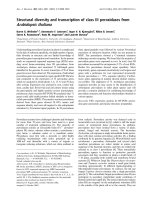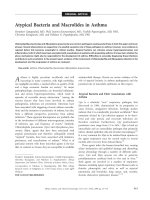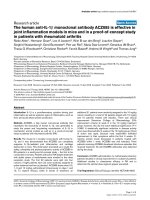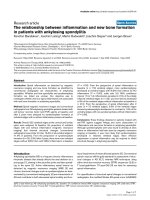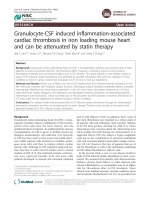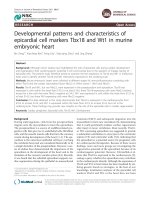Báo cáo y học: "Allergy, Asthma, and Inflammation: Which Inflammatory Cell Type Is More Importan" doc
Bạn đang xem bản rút gọn của tài liệu. Xem và tải ngay bản đầy đủ của tài liệu tại đây (119.34 KB, 7 trang )
150 Allergy, Asthma, and Clinical Immunology, Vol 4, No 4 (Winter), 2008: pp 150–156
ORIGINAL ARTICLE
Allergy, Asthma, and Inammation: Which Inammatory
Cell Type Is More Important?
Redwan Moqbel, PhD, FRCPath, and Solomon O. Odemuyiwa, DVM, PhD
A recent review in Allergy, Asthma, and Clinical Immunology suggested that eosinophils play a minor role, if any, in the inflammatory
spectrum of asthma and allergic inflammation. The article that dealt with mast cells suggested that the presence of these important
cells within the smooth muscle layer in asthmatic airways renders this cell type primal in asthma and an obvious and important target for
therapy. This article proposes that in a complex inflammatory milieu characterizing the complex syndromes we call asthma, no single
cell phenotype is responsible for the condition and thus should be a sole target for therapeutic strategies. Our reductionist approach
to research in asthma and related conditions has provided us with convincing evidence for multiple roles that immune, inflammatory,
and structural cell types can play in complex diseases. The next stage in understanding and ameliorating these complex conditions
is to move away from the simplistic notion of one cell type being more important than another. Instead, what is needed is to acquire
knowledge of intricate and exquisite biological systems that regulate such conditions in both health and disease involving various cell
types, mediators, pharmacologically active products, their multifaceted capacities, and their socio- biological networking.
Key words: Eosinophil; Mast cell; Th2; smooth muscle cell; mucosal immunity; eosinophilic bronchitis
strategies targeted at mast cells, rather than eosinophils, may
be a novel therapeutic option for the control of asthma.
The current article is not an attempt to praise the eosino-
phil and rush to defend its potential role in asthma or to at-
tack or denigrate the role of the mast cell. The aim, instead,
is to attract attention to the concept of complexity of systems
and to refute the notion that any given disease, and the even-
tual pathway to its control, may be due to the deleterious
action of one prominent cell type. In particular, the author
contended that, in contrast to other cell types, including the
eosinophils, the presence of mast cells within hypertrophied
smooth muscle layers in airway tissues in asthmatic patients
is indicative of the importance of this cell type, as a target for
therapy.
Eosinophils, Mast Cells, T- Helper 2–Type Response
and Allergic Asthma
We owe a debt of gratitude to Paul Ehrlich for rst describing
both the mast cell and the eosinophil. Early studies consis-
tently identied an association between these two cell types
and a number of disease conditions, most of which are now
known to be biased toward both innate and adaptive T- helper
(Th)- type response. Th- type responses are characterized
by increases in the levels of interleukin (IL)- and other Th
cytokines (IL- , IL- , IL- , and IL- ), activation and expan-
sion of CD
+
Th cells, plasma cells secreting IgE, eosinophils,
basophils, and mast cells, all of which can synthesize and re-
O
ur current understanding of the complex events associ-
ated with the immunobiology of inammation is pro-
gressively evolving. Research over the last century has pro-
vided an ever- expanding appreciation of the multifactorial
and complex nature of the wide spectrum of changes associ-
ated with immunity and inammation. Numerous players and
cascades contribute to both up- and downregulation of the po-
tential function and role of various immunologic, structural,
and inammatory cell types and other components in health
and disease. The article by Bradding in the previous issue of
this journal argued the case for the mast cell being the key cell
type in asthma. It was suggested that eosinophils, which are
major orchestrators of the pathophysiological changes seen
in asthma, could be used as biomarkers of disease phenotype
and response to therapy. The author, therefore, proposed that
Redwan Moqbel and Solomon O. Odemuyiwa: Pulmonary Research Group,
Department of Medicine, University of Alberta, Edmonton, AB.
Experimental work described in this review was supported by the Canadian
Institutes of Health Research and the Alberta Heritage Foundation for Medical
Research. R.M. is an Alberta Heritage Medical Senior Investigator.
Correspondence to: R Moqbel, PhD, FRCPath, Department of Immunology,
603 Basic Medical Sciences Building 730 Williams Avenue, University
of Manitoba Winnipeg, MB, Canada, R3E OW3, email:moqbelr@cc
.umanitoba .ca.
© The Canadian Society of Allergy, Asthma and Clinical Immunology
DOI 10.2310 / 7480.2008.00018
Moqbel and Odemuyiwa, Which Inammatory Cell Type Is More Important? 151
ings, Ach binds to M receptors on ASM cells; further release
of Ach is halted through the activity of M receptors on cho-
linergic nerve endings, limiting ASM constriction. Studies
in animal models and humans have shown that eosinophil-
derived MBP, found in the vicinity of cholinergic nerve end-
ings in asthmatics, inhibits the ability of M muscarinic
receptors to halt the release of Ach, leading to airway hyperre-
sponsiveness in asthmatics (AHR). The role of cholinergic
nerve endings and eosinophil- derived MBP in the pathophys-
iology of EB vis- à- vis asthma is currently unknown. None-
theless, it is quite instructive to note that the localization of
mast cells, in ASM cells or eosinophils, around cholinergic
nerve bres, in dierent phenotypes of eosinophilic airway
diseases, may determine the relative role of each cell type in
such conditions.
One Cell, One Disease, One Treatment?
Early studies reporting the preponderance of eosinophils in
allergic asthma and the toxicity of their granule- stored me-
diators indicated the need to focus on understanding eo-
sinophil eector function in vitro and in vivo. This resulted
in focused attention on targeting the eosinophil as a major
therapeutic strategy for asthma using novel approaches. This
included anti-eosinophil strategies, which were particularly
relevant since corticosteroids, choice therapies for asthma,
were shown to downregulate eosinophil counts in blood,
sputum, bronchoalveolar lavage (BAL), and airway tissue.
These changes correlated well with symptom improvement
and amelioration of disease severity. These studies led to
the discovery of IL- in the s and identication of the
range of its activities, especially its role as the most crucial
esoinophil terminal- dierentiating cytokine. As a result,
major pharmaceutical rms invested widely in the area of IL-
antagonism with the hope of blocking eosinophil inux into
the airway tissue and the subsequent associated inammatory
and damaging sequelae. Animal models, particularly studies
in monkeys, optimistically anticipated successful targeting of
a single cell phenotype in a complex disease condition. As
mentioned in the Bradding review , clinical trials with a hu-
manized anti- IL- monoclonal antibody, mepolizumab, were
disappointing. Indeed, it was shown that targeting the eosino-
phil is far more complex than blocking its dierentiation at
the level of the bone marrow and blood.
Following the poor results of mepolizumab, various labo-
ratories sought to understand the reasons behind the appar-
ent failure of this treatment in the management of asthma. To
start with, the Leckie and colleagues study was regarded to
have been not only well underpowered to appreciate statistical
dierences in the treatment group but also that the airways of
lease several types of Th cytokines. The observed prepon-
derance of eosinophils and mast cells in parasitic helminth in-
fections led to an upsurge in both in vitro and in vivo studies
examining the capacity of these cells to inuence the inam-
matory milieu associated with these infections in favour of the
host. It is now known that T cell–dependent recruitment
and activation of eosinophils and mast cells are a crucial step
toward the control of parasite- induced granulomas in tissues
and expulsion of adult worms from the gut. It was during the
s that elegant clinical studies pointed to a close statistical
correlation between airway tissue damage in asthma and the
activation of eosinophils as manifested by secretion of their
crystalloid granule- stored cationic proteins. Other stud-
ies also identied mast cell hyperplasia as an important com-
ponent of airway pathology in asthma. Since this discovery,
both cell types were subjects of extensive studies to determine
their precise roles in the immunopathology of asthma. Mast
cells and eosinophils synthesize, store, and release a similar
prole of Th cytokines. However, whereas mast cells store
and release histamine following activation, eosinophils store
and release cationic proteins. As previously indicated in the
Bradding article, mast cell–derived histamine plays a crucial
role in the induction of bronchial hyperresponsiveness dur-
ing the early phase of asthma. Conversely, the late- phase
response, seen in some asthmatics, is associated with activa-
tion of eosinophils; direct instillation of major basic protein
(MBP), derived from eosinophilic granules, into the lungs
of monkeys was shown, like mast cell–derived histamine, to
cause bronchospasm and increased smooth muscle respon-
siveness to methacholine.
A major argument advanced by Bradding to support
an “executive” role for mast cells in the pathophysiology of
asthma is the apparent similarity between the immunopathol-
ogy of asthma and eosinophilic bronchitis (EB) in spite of the
stark dierences in physiological derangement between the
two conditions. Bradding suggested that a major factor in
asthmatic AHR and airway smooth muscle (ASM) dysfunc-
tion seen in asthma but not in EB is likely due to the presence
of smooth muscle–inltrating mast cells in asthma, which
is absent in EB. This is an excellent argument that conrms
the notion that merely counting inammatory cells may not
necessarily indicate a role for such cells in a chronic inam-
matory disease; cells playing an eector role must be found
at the right place and time during the course of the disease.
Interestingly, a similar mechanism has been found for the in-
duction of AHR by eosinophils. Several studies have shown
that asthmatic airway tissue, unlike non- asthmatic controls,
is characterized by a preponderance of activated eosinophils,
releasing MBP, around cholinergic nerve bres. Following
the release of acetylcholine (Ach) from cholinergic nerve end-
152 Allergy, Asthma, and Clinical Immunology, Volume 4, Number 4, 2008
systems has allowed a carefully planned reductionist approach
toward understanding the role of specic factors in the immu-
nopathology of eosinophilic airway inammation. The use of
such models has shown that IL- - dependent dierentiation
of eosinophils in the bone marrow and eotaxin- dependent
recruitment of eosinophils to lung tissue are very important
in the generation of eosinophilic airway inammation.
–
However, a denitive role for eosinophils could not be es-
tablished until Lee and colleagues developed an eosinophil-
decient transgenic line of mice, the PHIL mouse, using a
method involving the developmental ablation of eosinophil
peroxidase–expressing progenitor cells through simultane-
ous activation of the diphtheria toxin A chain protein. Us-
ing this model, it was possible to show that the absence of
eosinophils resulted in the abrogation of all of the pathophys-
iologic features of allergic airway inammation, including
ASM hyperreactivity and mucus hypersecretion. However,
using this model, it was impossible to show whether the eect
of eosinophils was dependent on the release of granule- stored
proteins or other factors. A recent study from the same lab-
oratory further conrmed the role of eosinophils in severe
asthma; using an allergen- free model that systemically ex-
presses IL- in T cells and locally expresses eotaxin- in lung
epithelial cells, the authors demonstrated that the specic re-
cruitment of eosinophils to the airways resulted in the devel-
opment of pathological lesions compatible with severe asthma
in human. Thus, these studies showed that the eosinophil
is sucient for the genesis of the immunopathological de-
rangements seen in allergic airway inammation and the ex-
pression of the pathophysiological changes associated with
severe asthma.
In human studies, eosinophils have also been linked to
tissue remodelling, a critical feature of asthma, even in young
children. The cytokines thought to be involved, including
IL- , IL- , and transforming growth factor β (TGF- β),
as well as chemokines (eg, RANTES) known to be produced
by lymphocytes, are also synthesized, stored and released by
eosinophils. These cells may also be involved in airway re-
modelling through tenascin production; indeed, using an
allergen- induced cutaneous model of asthmatic inamma-
tion, it was shown that the release of TGF- β and IL- by
eosinophils contributes to airway remodelling.
Eosinophils and Immune Regulation
Recent studies have shown that eosinophils, in addition to
their eector role, may play an immunoregulatory role in
the immunopathogenesis of allergic asthma through interac-
tion with T cells. Eosinophils have been shown to inuence
the function of lymphocytes directly since they express co-
the positive control group were not hyperreactive, rendering
the main outcome of airway hyperreactivity (AHR) impos-
sible to assess accurately. Subsequent studies showed simi-
lar disappointing results with this antibody, suggesting that
eosinophils may not play a signicant role in airway hyper-
responsiveness. There was also doubt whether the presence of
eosinophils in sputum or airway uids truly reected those in
the airway tissue. Indeed, Flood- Page and colleagues showed
that mepolizumab depleted less than % of bronchial tissue
and bone marrow eosinophils while signicantly diminish-
ing blood and BAL uid eosinophils in treated subjects.
Whether this explains the observed lack of eect of anti- IL-
on AHR remains to be fully addressed. It is interesting that
Liu and colleagues later showed a marked reduction in the
expression of messenger ribonucleic acid of the surface IL-
receptor (mIL- Rα), as well as its intra cellular component
(mIL- Rβ), from BAL eosinophils in contrast to circulating
blood eosinophils. Further, airway eosinophils were shown
not to release eosinophil- derived neurotoxin (EDN) when
treated with IL- compared with their blood counterparts.
This suggests that the function (both survival and mediator
release) of BAL eosinophils may be independent of IL- .
Recent studies have reported that the reduction in blood and
sputum eosinophils in mepolizumab- treated subjects had an
eective steroid- sparing eect in patients with EB with or
without asthma.
It is important to note that the development, matura-
tion, and survival of the eosinophil may occur in situ in tis-
sue inammatory sites. It has been shown that eosinophil
progenitors released into the circulation reach tissue sites
and can dierentiate, in situ.
–
Furthermore, eosinophils
store and release up to dierent cytokines, chemokines,
and growth factors,
–
which may further amplify the in-
ammatory milieu. As such, in situ production of various
eosinophil- activating factors may be important in tissue eo-
sinophil reactions not involving IL- . More importantly, asso-
ciation studies are notoriously dicult in delineating the role
of specic cells or factors in disease since such studies are car-
ried out in patients already diagnosed with asthma. Thus, the
use of animal models has extended our understanding of the
role of inammatory cells in the pathophysiology of asthma.
Eosinophils Are Crucial in the Pathophysiology of
Asthma: The PHIL Mouse Model
Mouse model sensitization to ovalbumin (OVA) via the in-
traperitoneal route, followed by intranasal challenge with the
same protein, has been used to generate eosinophilic airway
inammation accompanied by AHR and other components
of allergic asthma. The advent of genetically modied mouse
Moqbel and Odemuyiwa, Which Inammatory Cell Type Is More Important? 153
response in the mouse through direct activation of Toll- like
receptor by EDN.
Eosinophil as a Marker of Allergic Disease and
Asthma Phenotyping
Atopic diseases such as asthma, dermatitis, and rhinitis are
classically associated with increased tissue eosinophils. The
presence of eosinophils has been correlated with disease se-
verity and bronchial hyperresponsiveness. Despite this as-
sociation, there is signicant heterogeneity among subgroups
in asthma and even within individual patients from season to
season. Clearly, dierent inammatory phenotypes are pres-
ent in asthmatics. For example, EB is characterized by an
increase in airway eosinophils, yet in contrast to asthma, AHR
does not appear to be a feature. This raises the question: Why
is EB not associated with AHR if eosinophils contribute to
AHR? In comparing mild asthma with EB, Brightling and col-
leagues found that although both groups had eosinophilia, the
signicant dierence in the airway pathology of the asthma
patient was the presence of mast cells within the smooth
muscle. This mast cell myositis was proposed as the cause of
AHR in asthma, which suggested that AHR, a key feature of
asthma, involves cells and mediators beyond the eosinophil.
Traditionally, mast cells are responsible for the acute
phase of the asthmatic response via IgE- mediated histamine
release and smooth muscle stimulation. Mild asthma, by de-
nition, can have AHR and acute periods of bronchospasm,
often allergy related. In contrast, patients with mild asthma
should not have decreased lung function by spirometry, nor
should they show exacerbations requiring hospitalization.
Thus, it was important to note that in a subsequent article by
many of the same authors interested in mast cell myositis, in
moderate to severe asthmatics, management of eosinophils
did make a dierence in asthma symptoms and outcomes.
After a run- in period in which they attempted to gain base-
line measurements of control with systemic and inhaled cor-
ticosteroids, patients with moderate to severe asthma were
randomized to two groups. One group received standard but
strict medical therapy based on the guidelines of the Brit-
ish Thoracic Society (BTS). The other group was managed
by the same guidelines but with the addition of regular spu-
tum analyses of eosinophilia or nitric oxide (NO) produc-
tion. The sputum group was closely monitored for direct evi-
dence of eosinophil activity in the airway as a signal to adjust
medication accordingly. Unlike the sputum group, the BTS
group had only symptoms and lung function to guide ther-
apy, which are the end result of inammatory damage. There
was a very convincing improvement in the outcomes for the
eosinophil- controlled group. Sputum eosinophil number and
stimulatory molecules essential for interaction with lympho-
cytes and were shown, at least in mice, to transmigrate to
and from lymphoid tissues and to present antigens to lym-
phocytes, albeit at a lower eciency than that of profes-
sional antigen- presenting cells to naive T cells. This supports
the notion that eosinophils can maintain and play a role in
immune responses.
Four areas involving the role of the eosinophil in immune
system regulation are worth emphasizing. The rst relates
to the fact that eosinophils naturally home to the thymus
during infancy and in the absence of any identiable “dan-
ger signal.” Thus, eosinophils may also be involved ear-
lier in the ontogeny of the immune response, as suggested
by studies showing that thymus eosinophils are active par-
ticipants in MHC class I–restricted deletion of autoreactive
T cells during the early neonatal period. Second, eosinophils
synthesize, store, and release at least dierent cytokines,
chemokines, and growth factors with the potential to regu-
late the local (in situ) immune and inammatory milieu in
lymphoid tissue. As such, eosinophil- derived cytokine
production may directly inuence T- cell selection by den-
dritic cells and may, therefore, determine the choice between
T- cell tolerance or activation. TGF- β, for which the eosino-
phil is a well- acknowledged source, has also been related
to T- lymphocyte subset development. The specic recruit-
ment of eosinophils into lymphoid tissues puts these cells in
a position to exert immunomodulatory eects on T cells in
eosinophil- associated diseases.
Third, the induction by interferon- γ (IFN- γ) of indoleam-
ine ,- dioxygenase (IDO), the rate- limiting enzyme in the
oxidative catabolism of tryptophan, may also be a signicant
and potent mechanism by which dendritic cells induce apop-
tosis and inhibit proliferation of T- helper cells. Lymphoid-
tissue eosinophils, either directly or indirectly, may induce
T- cell apoptosis through synthesis and release of IFN- γ, fol-
lowing the ligation of CD on eosinophils and subsequent
induction of IDO in dendritic cells. Our studies recently
showed that eosinophils constitutively express IDO and in-
duce Th but not Th apoptosis. Eosinophils may, therefore,
directly inuence T- cell function through tryptophan catab-
olism via eosinophil constitutive expression of biologically
active IDO.
The fourth indication that eosinophils have the capacity to
inuence T- cell regulation and its inammatory and damag-
ing sequelae was reports showing that EDN, a cationic pro-
tein stored in the crystalloid granules of eosinophils, induced
the migration and maturation of dendritic cells. Subsequent
studies from the same authors demonstrated that intratra-
cheal instillation of OVA- loaded dendritic cells pretreated
with EDN led to the enhancement of an OVA- specic Th
154 Allergy, Asthma, and Clinical Immunology, Volume 4, Number 4, 2008
present with the same clinical features of the disease or the
same pathologic inammatory proles. All of this conrms
the paradigm that asthma is a complex heterogeneous set of
syndromes and that treating the multitude of changes occur-
ring in the asthmatic airways requires targeting the complex-
ity of the inammatory cell phenotype environment with a
view to reducing the clinical manifestation of the condition.
We fully agree that conservative reductionist approaches have,
hitherto, served us well in understanding the potential func-
tions of various cells and molecules but may not necessarily
generate the best therapeutic options in a disease character-
ized by complex cellular and cytokine dyscrasia. Of note is the
fact that the most eective asthma drugs to date, corticoste-
roids, target multiple cell types involved in the chronic in-
ammation that characterizes asthma. Our next major chal-
lenge is to begin thinking about how we target systems and
make sense of the extraordinary amount of data obtained
from the complex setting of multiple phenotypes of asthma
and tissue and organ environment in an individualized fash-
ion, avoiding the current “shotgun” approach of therapeutic
intervention. As well, it is likely that targeting a functional
pathway common to all inammatory cellular inltrates in
asthma may prove to be an excellent future strategy in asthma
therapy. In this regard, a major bias of our laboratory pro-
poses that targeting specic elements involved in intracel-
lular mechanisms regulating exocytosis leading to mediator
release, a common feature of all immune and inammatory
cells, may be an ecient path to pursue in this regard.
In conclusion, any attempt at ascribing a precise role
for any given immune, inammatory, or structural cell type
in asthma will be constantly hampered by the recognition
that asthma is not a single clinical entity and should, there-
fore, not be expected to be associated with or dependent on
a single cell- type function. One disease, one cell type, one
molecule will never be a viable approach to such a complex
condition. Instead, what is needed is a better and more ac-
curate phenotyping of asthma and a greater appreciation of
patient- directed, rather than disease- directed, therapies. It is
our rm conviction that complex diseases require complex
therapeutic approaches.
References
1. Bradding P. Allergy Asthma Clin Immunol 2008;4:84–90.
2. Brightling CE, Bradding P, Symon FA, et al. Mast- cell inltration of air-
way smooth muscle in asthma. N Engl J Med 2002;346:1699–705.
3. Ehrlich P. Ueber die specischen granulationen des Blutes. Arch Anat
Physiol LPZ 1879;3:571.
4. Anthony RM, Rutitzky LI, Urban JF Jr, et al. Protective immune mecha-
nisms in health infection. Nat Rev Immunol 2007;7:975–87.
NO production were decreased by % and %, respectively,
compared with the BTS group. The sputum group had lowered
AHR, fewer exacerbations, lower prednisone doses, and fewer
admissions to hospital while receiving the same inhaled ste-
roid dose. Further, in patients with low eosinophil numbers,
the inhaled steroid dose could be lowered in the sputum group.
It appears that because the sputum group provided ear-
lier information about the degree of inammation reected
by eosinophilia, the asthma in this group could be controlled
before eosinophil activity caused damage and subsequent
clinical morbidity. Thus, just as the type of animal model is
important in the study of eosinophils, depending on the clini-
cal phenotype of the asthma patient, the role of the eosino-
phil may also vary. Knowing both the inammatory prole
and the clinical categorization of the patient develops a clearer
phenotype of the asthma patient and appears to contribute to
improved asthma care.
The ultimate goal in asthma therapy will continue to be
the development of the most eective anti- inammatory
strategy for individual patients. Thus, the focus may be to
correlate the clinical picture of the asthmatic patient with the
inammation in the tissue; such correlations will provide dis-
tinct phenotypes of asthma. Eosinophils are extremely sensi-
tive to the eects of glucocorticosteroids. The subpopulation
of asthmatics who have a primarily neutrophilic airway in-
ammation may be better served by an alternative agent to
control inammation than glucocorticosteroids. Underrecog-
nition of ongoing airway inammation despite clinical remis-
sion is a problem for both patients and physicians. Lower
airway inammation can be evaluated safely and in a non-
invasive fashion by measuring changes in induced sputum.
The use of the latter in evaluating asthmatics has now evolved
from the research arena to clinical management. Character-
ization also depends on the compartment analyzed (sputum,
blood, urine). Eosinophils from blood and BAL express dier-
ent cell surface markers following allergen challenge. Cor-
relating which compartment is the most relevant for clinical
response to therapy will also be important.
Paradigm of Convergence
The unied goal of all asthma researchers is to identify thera-
peutic strategies to reverse the chronic inammatory response
associated with this serious and complex condition. A ma-
jor and painful lesson acquired through increasing evidence
from a wide range of studies is that developing asthma therapy
that targets a single inammatory cell type or a particular cell
or inammatory product will not lead to a signicant remis-
sion of asthma symptoms. After all, patients do not uniformly
Moqbel and Odemuyiwa, Which Inammatory Cell Type Is More Important? 155
brane IL- 5 receptor alpha on human eosinophils: I. Loss of mem-
brane IL- 5 receptor alpha on airway eosinophils and increased soluble
IL- 5 receptor alpha in the airway aer allergen challenge. J Immunol
2002;169:6452–8.
27. Liu LY, Sedgwick JB, Bates ME, et al. Decreased expression of mem-
brane IL- 5 receptor alpha on human eosinophils: II. IL- 5 down-
modulates its receptor via a proteinase- mediated process. J Immunol
2002;169:6459–66.
28. Nair P, Pizzichini M, Kjarsgaard M, et al. Abstract in the American Jour-
nal of Respiratory and Critical Care Medicine. Am J Respir Crit Care
Med 2008;177:A568.
29. Denburg JA. Bone marrow in atopy and asthma: hematopoietic mecha-
nisms in allergic inammation. Immunol Today 1999;20:111–3.
30. Cameron L, Christodoulopoulos P, Lavigne F, et al. Evidence for local
eosinophil dierentiation within allergic nasal mucosa: Inhibition with
soluble IL- 5 receptor. J Immunol 2000;164:1538–45.
31. Simon HU, Youse S, Schranz C, et al. Direct demonstration of delayed
eosinophil apoptosis as a mechanism causing tissue eosinophilia. J Im-
munol 1997;158:3902–8.
32. Eidelman DH, Minshall E, Dandurand RJ, et al. Evidence for major ba-
sic protein immunoreactivity and interleukin 5 gene activation during
the late phase response in explanted airways. Am J Respir Cell Mol Biol
1996;15:582–9.
33. Levi- Schaer F, Lacy P, Severs NJ, et al. Association of granulocyte-
macrophage colony- stimulating factor (GM- CSF) with the crystalloid
granules of human eosinophils. Blood 1995;85:2579–86.
34. Moqbel R, Hamid Q, Ying S, et al. Expression of mRNA and immu-
noreactivity for the granulocyte / macrophage colony- stimulating fac-
tor (GM- CSF) in activated human eosinophils. J Exp Med 1991;174:
749–52.
35. Anwar AR, Moqbel R, Walsh GM, et al. Adhesion to bronectin pro-
longs eosinophil survival. J Exp Med 1993;177:839–43.
36. Justice JP, Borchers MT, Crosby JR, et al. Ablation of eosinophils leads
to a reduction of allergen- induced pulmonary pathology. Am J Physiol
Lung Cell Mol Physiol 2003;284:L169–78.
37. Shen HH, Ochkur SI, McGarry MP, et al. A causative relationship ex-
ists between eosinophils and the development of allergic pulmonary
pathologies in the mouse. J Immunol 2003;170:3296–305.
38. Lee NA, McGarry MP, Larson KA, et al. Expression of IL- 5 in thymo-
cytes / T cells leads to the development of a massive eosinophilia, ex-
tramedullary eosinophilopoiesis, and unique histopathologies. J Immu-
nol 1997;158:1332–44.
39. Foster PS, Hogan SP, Ramsay AJ, et al. Interleukin 5 deciency abol-
ishes eosinophilia, airways hyperreactivity, and lung damage in a mouse
asthma model. J Exp Med 1996;183:195–201.
40. Ochkur SI, Jacobsen EA, Protheroe CA, et al. Coexpression of IL- 5 and
eotaxin- 2 in mice creates an eosinophil- dependent model of respira-
tory inammation with characteristics of severe asthma. J Immunol
2007;178:7879–89.
41. Lee JJ, Dimina D, Macias MP, et al. Dening a link with asthma in mice
congenitally decient in eosinophils. Science 2004;305:1773–6.
42. Woerly G, Lacy P, Younes AB, et al. IL- 13 release by human eosinophils
following CD28- dependent activation. J Leukoc Biol 2002;72:769–79.
43. Schmid- Grendelmeier P, Altznauer F, Fischer B, et al. Eosinophils ex-
press functional IL- 13 in eosinophilic inammatory diseases. J Immu-
nol 2002;169:1021–7.
44. Wong DT, Weller PF, Galli SJ, et al. Human eosinophils express trans-
forming growth factor alpha. J Exp Med 1990;172:673–81.
5. Tato CM, Laurence A, O’Shea JJ. Helper T cell dierentiation enters a
new era: le roi est mort; vive le roi! J Exp Med 2006;203:809–12.
6. Butterworth AE, Vadas MA, Wassom DL, et al. Interactions between
human eosinophils and schistosomula of Schistosoma mansoni. II. The
mechanism of irreversible eosinophil adherence. J Exp Med 1979;150:
1456–71.
7. Butterworth AE, David JR. Eosinophil function. N Engl J Med 1981;
304:154–6.
8. Meeusen EN, Balic A, Bowles V. V. Cells, cytokines and other molecules
associated with rejection of gastrointestinal nematode parasites. Vet Im-
munol Immunopathol 2005;108:121–5.
9. Filley WV, Holley KE, Kephart GM, Gleich GJ. Identication by immu-
nouorescence of eosinophil granule major basic protein in lung tissues
of patients with bronchial asthma. Lancet 1982;2:11–6.
10. Frigas E, Gleich GJ. The eosinophil and the pathophysiology of asthma.
J Allergy Clin Immunol 1986;77:527–37.
11. Moqbel R, Coughlin JJ. Dierential secretion of cytokines. Sci STKE
2006;(338):pe26.
12. Cieslewicz G, Tomkinson A, Adler A, et al. The late, but not early, asth-
matic response is dependent on IL- 5 and correlates with eosinophil in-
ltration. J Clin Invest 1999;104:301–8.
13. Gleich GJ, Adolphson C. Bronchial hyperreactivity and eosinophil
granule proteins. Agents Actions Suppl 1993;43:223–30.
14. Fryer AD, Adamko DJ, Yost BL, Jacoby DB. Eects of inammatory
cells on neuronal M2 muscarinic receptor function in the lung.Life Sci
1999;64:449–55.
15. Fryer AD, Jacoby DB. Function of pulmonary M2 muscarinic receptors
in antigen- challenged guinea pigs is restored by heparin and poly- L-
glutamate. J Clin Invest 1992;90:2292–8.
16. Fryer AD, Maclagan J. Muscarinic inhibitory receptors in pulmonary
parasympathetic nerves in the guinea- pig. Br J Pharmacol 1984;83:973–8.
17. Fryer AD, Stein LH, Nie Z, et al. Neuronal eotaxin and the eects of
CCR3 antagonist on airway hyperreactivity and M2 receptor dysfunc-
tion. J Clin Invest 2006;116:228–36.
18. Adamko DJ, Yost BL, Gleich GJ, et al. Ovalbumin sensitization changes
the inammatory response to subsequent parainuenza infection. Eo-
sinophils mediate airway hyperresponsiveness, m(2) muscarinic recep-
tor dysfunction, and antiviral eects. J Exp Med 1999;190:1465–78.
19. Wardlaw AJ, Moqbel R, Kay AB. Eosinophils: biology and role in dis-
ease. Adv Immunol 1995;60:151–266.
20. Clutterbuck E, Shields JG, Gordon J, et al. Recombinant human inter-
leukin 5 is an eosinophil dierentiation factor but has no activity in stan-
dard human B cell growth factor assays. Eur J Immunol 1987;17:1743–50.
21. Sanderson CJ. Interleukin- 5, eosinophils, and disease Blood 1992;79:
3101–9.
22. Egan RW, Athwahl D, Chou CC, et al. Pulmonary biology of anti-
interleukin 5 antibodies Mem Inst Oswaldo Cruz 1997;92 Suppl 2:69–73.
23. Kips JC, O’Connor BJ, Langley SJ, et al. Eect of SCH55700, a human-
ized anti- human interleukin- 5 antibody, in severe persistent asthma: a
pilot study. Am J Respir Crit Care Med 2003;167:1655–9.
24. Leckie MJ, ten Brinke A, Khan J, et al. Eects of an interleukin- 5 block-
ing monoclonal antibody on eosinophils, airway hyper- responsiveness,
and the late asthmatic response Lancet 2000;356:2144–8.
25. Flood- Page PT, Menzies- Gow AN, Kay AB, Robinson DS. Eosinophil’s
role remains uncertain as anti- interleukin- 5 only partially depletes
numbers in asthmatic airway. Am J Respir Crit Care Med 2003;167:
199–204.
26. Liu LY, Sedgwick JB, Bates ME, et al. Decreased expression of mem-
156 Allergy, Asthma, and Clinical Immunology, Volume 4, Number 4, 2008
58. Odemuyiwa SO, Ghahary A, Li Y, et al. Cutting Edge: Human eo-
sinophils can regulate T- cell subset selection through indoleamine 2,
3- dioxygenase. J Immunol 2004;173:5909–13.
59. Yang D, Rosenberg HF, Chen Q, et al. Eosinophil- derived neurotoxin
(EDN), an antimicrobial protein with chemotactic activities for den-
dritic cells. Blood 2003;102:3396–403.
60. Yang D, Chen Q, Su SB, et al. Eosinophil- derived neurotoxin acts as an
alarmin to activate the TLR2- MyD88 signal pathway in dendritic cells
and enhances Th2 immune responses. J Exp Med 2008;205:79–90.
61. Gleich GJ, Adolphson CR, Leiferman KM. The biology of the eosino-
philic leukocyte. Annu Rev Med 1993;44:85–101.
62. Woodru PG, Khashayar R, Lazarus SC, et al. Relationship between
airway inammation, hyperresponsiveness, and obstruction in asthma.
J Allergy Clin Immunol 2001;108:753–8.
63. O’Donnell RA, Frew AJ. Is there more than one inammatory pheno-
type in asthma? Thorax 2002;57:566–8.
64. Holloway JW, Yang IA, Holgate ST. Interpatient variability in rates of
asthma progression: can genetics provide an answer? J Allergy Clin Im-
munol 2008;121:573–9.
65. Green RH, Brightling CE, McKenna S, et al. Asthma exacerbations
and sputum eosinophil counts: a randomised controlled trial. Lancet
2002;360:1715–21.
66. van den Toorn LM, Overbeek SE, de Jongste JC, et al. Airway inamma-
tion is present during clinical remission of atopic asthma. Am J Respir
Crit Care Med 2001;164:2107–13.
67. Pizzichini E, Pizzichini MM, Ehimiadis A, et al. Indices of airway
inammation in induced sputum: reproducibility and validity of cell
and uid- phase measurements. Am J Respir Crit Care Med 1996;154(2
Pt 1):308–17.
68. Jayaram L, Parameswaran K, Sears MR, Hargreave FE. Induced spu-
tum cell counts: their usefulness in clinical practice. Eur Respir J
2000;16:150–8.
69. Mengelers HJ, Maikoe T, Brinkman L, et al. Immunophenotyping of
eosinophils recovered from blood and BAL of allergic asthmatics. Am J
Respir Crit Care Med 1994;149(2 Pt 1):345–51.
45. Velazquez JR, Lacy P, Mahmudi- Azer S, et al. Interleukin- 4 and
RANTES expression in maturing eosinophils derived from human cord
blood CD34
+
progenitors. Immunology 2000;101:419–25.
46. Phipps S, Ying S, Wangoo A, et al. The relationship between allergen-
induced tissue eosinophilia and markers of repair and remodeling in
human atopic skin. J Immunol 2002;169:4604–12.
47. Celestin J, Rotschke O, Falk K, et al. IL- 3 induces B7.2 (CD86) ex-
pression and costimulatory activity in human eosinophils. J Immunol
2001;167:6097–104.
48. MacKenzie JR, Mattes J, Dent LA, Foster PS. Eosinophils promote aller-
gic disease of the lung by regulating CD4(+) Th2 lymphocyte function.
J Immunol 2001;167:3146–55.
49. Shi HZ, Humbles A, Gerard C, et al. Lymph node tracking and anti-
gen presentation by endobronchial eosinophils. J Clin Invest 2000;105:
945–53.
50. Matthews AN, Friend DS, Zimmermann N, et al. Eotaxin is required
for the baseline level of tissue eosinophils. Proc Natl Acad Sci U S A
1998;95:6273–8.
51. Contreiras EC, Lenzi HL, Meirelles MN, et al. The equine thymus
micro environment: a morphological and immunohistochemical analy-
sis. Dev Comp Immunol 2004;28:251–64.
52. Throsby M, Herbelin A, Pleau JM, Dardenne M. CD11c+ eosinophils
in the murine thymus: developmental regulation and recruitment
upon MHC class I- restricted thymocyte deletion. J Immunol 2000;165:
1965–75.
53. Lacy P, Moqbel R. Molecular mechanisms in eosinophil activation.
Chem Immunol 2000;76:134–55.
54. Gharaee- Kermani M, Phan SH. The role of eosinophils in pulmonary
brosis. Int J Mol Med 1998;1:43–53.
55. Gorelik L, Flavell RA. Transforming growth factor- beta in T- cell biol-
ogy. Nat Rev Immunol 2002;2:46–53.
56. Fallarino F, Grohmann U, Vacca C, et al. T cell apoptosis by tryptophan
catabolism. Cell Death Dier 2002;9:1069–77.
57. Woerly G, Roger N, Loiseau S, et al. Expression of CD28 and CD86 by
human eosinophils and role in the secretion of type 1 cytokines (in-
terleukin 2 and interferon gamma): inhibition by immunoglobulin a
complexes. J Exp Med 1999;190:487–95.
